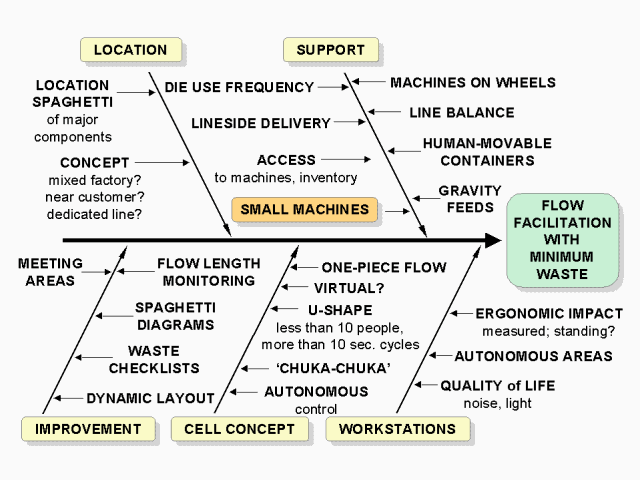
Lean and LAYOUT

Layout sets the scene for Lean. Poor layout is perhaps the greatest ongoing source of waste and the greatest opportunity. Layout is a key facilitator because it makes small batch or one-piece-flow possible. By contrast, with non-Lean layout there is no option but to move parts around in surging batches. Layout is also key to improved quality. So the overriding layout principle is to move machines and processes closer together, as soon as and whenever opportunities arise. (Opportunities always arise when buffer stock is reduced, when new machines are acquired, with new products, when changeover is reduced, and so on.) Traditional re-layout tended to take place only periodically; with Lean, layout changes are made much more frequently.
Layout should be thought of as a hierarchical process - from plant location to factory layout, to cell layout, to workstation design.
Begin with a spaghetti diagram showing how major components get moved around before arriving at the plant and after they leave. Calculate the speed of this movement and ask searching questions on transport, location and batch sizes.
Plant concept reminds one to consider the relative merits of a mixed plant serving several customers, dedicated customer cells or lines on own site, a dedicated focused plant near a major customer, or moving onto a customer's site. The same considerations apply in reverse to your major suppliers.
There are a whole raft of concepts which aid Lean layout. Machines on wheels offer ultimate flexibility but may not be practical. Die use frequency reminds us to locate more frequently used dies closer to the machines that use them. Do a Pareto analysis. Lineside delivery by suppliers is the ideal, but a supermarket may be an interim solution. Cells and lines should be balanced against takt time, using actual times (no allowances). Breaks are taken more frequently, and work is at standard rate or zero (see Standards section). The shojinka concept alters the number of operators depending on takt time. This makes cross training necessary. Containers should be human-movable if possible, or parts moved by gravity feed. Machines require access, particularly around the back. Inventory footprints should be shown. The Small Machine concept is a major facilitator.
The fundamental advantage of cells is one-piece flow. The reason is reduction in lead-time. This is Little's Law:
so for a constant throughput, lead-time is directly proportional to batch size. If flow is not one-piece, you do not have a Lean cell! Inventory standards should exist in every cell. A Lean ideal is frequently U-shape with operators within arm's length. There may be a series of U-cells. Cycle time less than about 10 seconds are undesirable for checking and improvement reasons. More than about 10 people in a cell prevents full cross training flexibility and works against the team concept. A variation is the chuka chuka line that slowly moves a wheeled pallet past a workstation in the takt time. Another is the virtual cell that is used if machines are too large to locate into a physical cell. Here operators from several sequential processes work as a team rather than for their own process department. Simplicity of control and reduced lead-time frequently more than compensate for any capacity loss. Cells should be autonomous with integrated quality, maintenance, and sometimes schedule responsibility.
Workstations need to be designed with their ergonomic impact and the waste of motion in mind. Minimise both horizontal and vertical movement of parts and tools. Standing may be better than sitting for flexibility and posture. Autonomous layout means full responsibility in designated areas. Quality of life should be improved considering noise, lights, floors, and of course safety.
Improvement begins by knowing flow lengths and trying to minimise them. Spaghetti diagrams are powerful aids at factory and workstation level. Waste checklists, prepared by a Lean promotion office, help to keep muda in mind. Meeting areas, in which performance is displayed, are great for teamwork and improvement. A flip chart to note problems should be an essential in every cell.